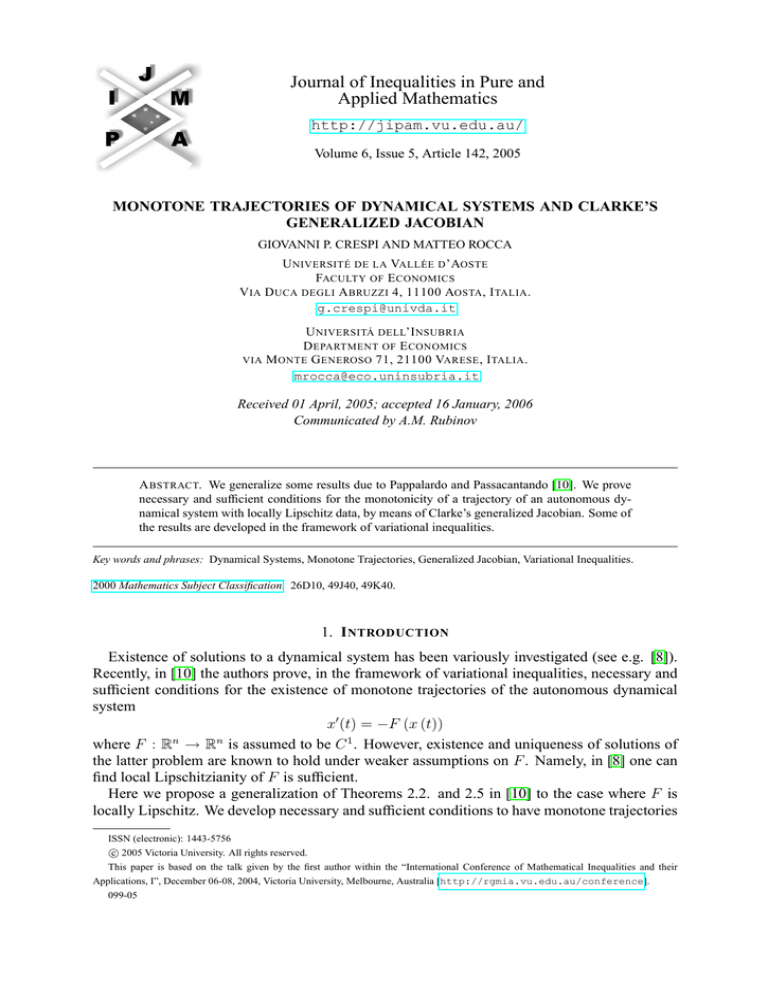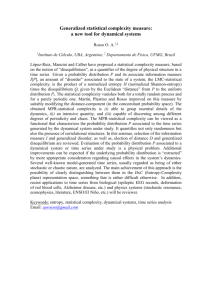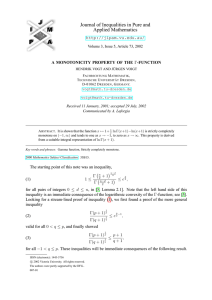
Journal of Inequalities in Pure and
Applied Mathematics
http://jipam.vu.edu.au/
Volume 6, Issue 5, Article 142, 2005
MONOTONE TRAJECTORIES OF DYNAMICAL SYSTEMS AND CLARKE’S
GENERALIZED JACOBIAN
GIOVANNI P. CRESPI AND MATTEO ROCCA
U NIVERSITÉ DE LA VALLÉE D ’AOSTE
FACULTY OF E CONOMICS
V IA D UCA DEGLI A BRUZZI 4, 11100 AOSTA , I TALIA .
g.crespi@univda.it
U NIVERSITÁ DELL’I NSUBRIA
D EPARTMENT OF E CONOMICS
VIA M ONTE G ENEROSO 71, 21100 VARESE , I TALIA .
mrocca@eco.uninsubria.it
Received 01 April, 2005; accepted 16 January, 2006
Communicated by A.M. Rubinov
A BSTRACT. We generalize some results due to Pappalardo and Passacantando [10]. We prove
necessary and sufficient conditions for the monotonicity of a trajectory of an autonomous dynamical system with locally Lipschitz data, by means of Clarke’s generalized Jacobian. Some of
the results are developed in the framework of variational inequalities.
Key words and phrases: Dynamical Systems, Monotone Trajectories, Generalized Jacobian, Variational Inequalities.
2000 Mathematics Subject Classification. 26D10, 49J40, 49K40.
1. I NTRODUCTION
Existence of solutions to a dynamical system has been variously investigated (see e.g. [8]).
Recently, in [10] the authors prove, in the framework of variational inequalities, necessary and
sufficient conditions for the existence of monotone trajectories of the autonomous dynamical
system
x0 (t) = −F (x (t))
where F : Rn → Rn is assumed to be C 1 . However, existence and uniqueness of solutions of
the latter problem are known to hold under weaker assumptions on F . Namely, in [8] one can
find local Lipschitzianity of F is sufficient.
Here we propose a generalization of Theorems 2.2. and 2.5 in [10] to the case where F is
locally Lipschitz. We develop necessary and sufficient conditions to have monotone trajectories
ISSN (electronic): 1443-5756
c 2005 Victoria University. All rights reserved.
This paper is based on the talk given by the first author within the “International Conference of Mathematical Inequalities and their
Applications, I”, December 06-08, 2004, Victoria University, Melbourne, Australia [http://rgmia.vu.edu.au/conference].
099-05
2
G IOVANNI P. C RESPI
AND
M ATTEO ROCCA
of the autonomous (projected) dynamical system, expressed in terms of Clarke’s generalized
Jacobian [3]. The main results are proved in Section 3, while Section 2 is devoted to preliminary
results and definitions.
2. P RELIMINARIES
Throughout the paper we make use of some relations between differential inclusions and
variational inequalities. For the sake of completeness, we recall some of them together with the
standard notation. We shall consider a convex and closed feasible region K ⊂ Rn and an upper
n
semi-continuous (u.s.c.) map F from Rn to 2R , with nonempty convex and compact values.
2.1. Differential Inclusions. We start by recalling from [1] the following result about projection:
Theorem 2.1. We can associate to every x ∈ Rn a unique element πK (x) ∈ K, satisfying:
kx − πK (x)k = min kx − yk.
y∈K
It is characterized by the following inequality:
hπK (x) − x, πK (x) − yi ≤ 0,
∀y ∈ K.
Furthermore the map πK (·) is non expansive, i.e.:
kπK (x) − πK (y)k ≤ kx − yk.
The map πK is said to be the projector (of best approximation) onto K. When K is a linear
subspace, then πK is linear (see [1]). For our aims, we set also:
[
πK (A) =
πK (x).
x∈A
The following notation should be common:
C − = {v ∈ Rn : hv, ai ≤ 0, ∀a ∈ C}
is the (negative) polar cone of the set C ⊆ Rn , while:
T (C, x) = {v ∈ Rn : ∃vn → v, αn > 0, αn → 0, x + αn vn ∈ C}
is the Bouligand tangent cone to the set C at x ∈ clC and N (C, x) = [T (C, x)]− stands for the
normal cone to C at x ∈ clC.
It is known that T (C, x) and N (C, x) are closed sets and N (C, x) is convex. Furthermore,
when we consider a closed convex set K ⊆ Rn , then T (K, x) = cl cone (K − x) (cone A
denotes the cone generated by the set A), so that also the tangent cone is convex.
n
Given a map G : K ⊆ Rn → 2R , a differential inclusion is the problem of finding an
absolutely continuous function x(·), defined on an interval [0, T ], such that:
(
∀t ∈ [0, T ],
x(t) ∈ K,
for a.a. t ∈ [0, T ], x0 (t) ∈ G(x(t)).
The solutions of the previous problem are also called trajectories of the differential inclusion.
We are concerned with the following problem, which is a special case of differential inclusion.
Problem 2.1. Find an absolutely continuous function x(·) from [0, T ] into Rn , satisfying:
(
∀t ∈ [0, T ],
x(t) ∈ K,
(P DI(F, K))
for a.a. t ∈ [0, T ], x0 (t) ∈ πT (K,x(t)) (−F (x(t)) ,
J. Inequal. Pure and Appl. Math., 6(5) Art. 142, 2005
http://jipam.vu.edu.au/
M ONOTONE TRAJECTORIES OF DYNAMICAL SYSTEMS
3
The previous problem is usually named “projected differential inclusion” (for short, P DI).
Theorem 2.2. The solutions of Problem 2.1 are the solutions of the “differential variational
inequality” (DV I):
(
∀t ∈ [0, T ],
x(t) ∈ K,
(DV I(F, K))
for a.a. t ∈ [0, T ], x0 (t) ∈ −F (x(t)) − N (K, x(t))
and conversely.
Remark 2.3. We recall that when F is a single-valued operator, then the corresponding “projected differential equation” and its applications have been studied for instance in [5, 9, 10].
Definition 2.1. A point x∗ ∈ K is an equilibrium point for P DI(F, K), when:
0 ∈ −F (x∗ ) − N (K, x∗ ).
In our main results we make use of the monotonicity of a trajectory of P DI(F, K), as stated
in [1].
Definition 2.2. Let V be a function from K to R+ . A trajectory x(t) of P DI(F, K) is monotone
(with respect to V ) when:
∀t ≥ s,
V (x(t)) − V (x(s)) ≤ 0.
If the previous inequality holds strictly ∀t > s, then we say that x(t) is strictly monotone w.r.t.
V.
We apply the previous definition to the function:
kx − x∗ k2
,
2
where x∗ is an equilibrium point of P DI(F, K).
Ṽx∗ (x) =
2.2. Variational Inequalities.
Definition 2.3. A point x∗ ∈ K is a solution of a Strong Minty Variational Inequality (for short,
SM V I), when:
(SM V I(F, K))
hξ, y − x∗ i ≥ 0,
∀y ∈ K, ∀ξ ∈ F (y).
Definition 2.4. A point x∗ ∈ K is a solution of a Weak Minty Variational Inequality (for short,
W M V I), when ∀y ∈ K, ∃ξ ∈ F (y) such that:
(W M V I(F, K))
hξ, y − x∗ i ≥ 0.
Definition 2.5. If in Definition 2.3 (resp. 2.4), strict inequality holds ∀y ∈ K, y 6= x∗ , then we
say that x∗ is a “strict” solution of SM V I(F, K) (resp. of W M V I(F, K)).
Remark 2.4. When F is single valued, Definitions 2.3 and 2.4 reduce to the classical notion of
(M V I).
The following results relate the monotonicity of trajectories of P DI(F, K) w.r.t. Ṽx∗ to
solutions of Minty Variational Inequalities.
n
Definition 2.6. A set valued map F : Rn ⇒ 2R is said to be upper semicontinuous (u.s.c.) at
x0 ∈ Rn , when for every open set N containing F (x0 ), there exists a neighborhood M of x0
such that F (M ) ⊆ N .
F is said to be u.s.c. when it is so at every x0 ∈ Rn .
J. Inequal. Pure and Appl. Math., 6(5) Art. 142, 2005
http://jipam.vu.edu.au/
4
G IOVANNI P. C RESPI
AND
M ATTEO ROCCA
Theorem 2.5 ([4]). If x∗ ∈ K is a solution of SM V I(F, K), where F is u.s.c. with nonempty
convex compact values, then every trajectory x(t) of P DI(F, K) is monotone w.r.t. function
Ṽx∗ .
Theorem 2.6 ([4]). Let x∗ be an equilibrium point of P DI(F, K). If for any point x ∈ K there
exists a trajectory of P DI(F, K) starting at x and monotone w.r.t. function Ṽx∗ , then x∗ solves
W M V I(F, K).
Proposition 2.7 ([4]). Let x∗ be a strict solution of SM V I(F, K), then:
i) x∗ is the unique equilibrium point of P DI(F, K);
ii) every trajectory of P DI(F, K), starting at a point x0 ∈ K and defined on [0, +∞) is
strictly monotone w.r.t. Ṽx∗ and converges to x∗ .
Example 2.1. Let K = R2 and consider the system of autonomous differential equations:
x0 (t) = −F (x(t)),
where F : R2 → R2 is a single-valued map defined as:
"
#
−y + x|1 − x2 − y 2 |
F (x, y) =
.
x + y|1 − x2 − y 2 |
Clearly (x∗ , y ∗ ) = (0, 0) is an equilibrium point and one has hF (x, y), (x, y)i ≥ 0 ∀(x, y) ∈ R2 ,
so that (0, 0) is a solution of GM V I(F, K) and hence, according to Theorem 2.5, every solution
x(t) of the considered system of differential equations is monotone w.r.t. Ṽx∗ . Anyway, not all
the solutions of the system converge to (0, 0). In fact, passing to polar coordinates, the system
can be written as:
( 0
ρ (t) = −ρ(t)|1 − ρ2 (t)|
θ0 (t) = −1
and solving the system, one can easily see that the solutions that start at a point (ρ, θ), with
ρ ≥ 1 do not converge to (0, 0), while the solutions that start at a point (ρ, θ) with ρ < 1
converge to (0, 0). This last fact can be checked on observing that for every c < 1, (0, 0) is a
strict solution of SM V I(F, Kc ) where:
Kc := {(x, y) ∈ R2 : x2 + y 2 < c}.
Proposition 2.7 is useful in the proof of necessary and sufficient conditions for the existence
of monotone trajectories of DS(F ), expressed by means of Clarke’s generalized Jacobian [3].
Definition 2.7. Let G be a locally Lipschitz function from K to Rm . Clarke’s generalized
Jacobian of G at x is the subset of the space Rn×m of n × m matrices, defined as:
JC G(x) = conv{lim JG(xk ) : xk → x, G is differentiable at xk }
(here JG denotes the Jacobian of G and conv A stands for the convex hull of the set A ⊆ Rn ).
The following proposition summarizes the main properties of the generalized Jacobian.
Proposition 2.8.
i) JC F (x) is a nonempty, convex and compact subset of Rn×m ;
ii) the map x → JC F (x) is u.s.c.;
iii) (Mean value Theorem) For all x, y ∈ K we have F (y) − F (x) ∈ conv{JC F (x + δ(y −
x))(y − x), δ ∈ [0, 1]}.
J. Inequal. Pure and Appl. Math., 6(5) Art. 142, 2005
http://jipam.vu.edu.au/
M ONOTONE TRAJECTORIES OF DYNAMICAL SYSTEMS
5
Definition 2.8. Let G(·) be a map from Rn into the subsets of the space Rn×n of n × n matrices.
We say that G(·) is positively defined at x (respectively weakly positively defined) on K when:
inf u> Gu ≥ 0,
G∈G(x)
sup u> Gu ≥ 0,
∀u ∈ T (K, x)
!
∀u ∈ T (K, x)
G∈G(x)
If the inequality is strict (for u 6= 0), we say that G(x) is strictly positively defined (resp. strictly
weakly positively defined).
3. M AIN R ESULTS
Theorem 3.1. Let F : K → Rn be locally Lipschitz and let x∗ be an equilibrium point of
P DI(F, K). If there exists a positive number δ such that for any x0 ∈ K with kx0 − x∗ k < δ,
there exists a trajectory x(t) of P DI(F, K) starting at x0 and monotone w.r.t. Ṽx∗ , then Clarke’s
generalized Jacobian of F at x∗ is weakly positively defined on K.
Proof. Let B(x∗ , δ) be the open ball with center in x∗ and radius δ. Fix z ∈ B(x∗ , δ) ∩ K and
let y(α) = x∗ + α(z − x∗ ), for α ∈ [0, 1] (clearly y(α) ∈ B(x∗ , δ) ∩ K). Let x(t) be a trajectory
of P DI(F, K) starting at y(α); for v(t) = Ṽx∗ (x(t)), we have:
0 ≥ v 0 (0) = hx0 (0), y(α) − x∗ i,
and:
x0 (0) = −F (y(α)) − n,
n ∈ N (K, y (α))
so that:
hF (y (α)) , y(α) − x∗ i ≥ −hn, y(α) − x∗ i ≥ 0.
Now, applying the mean value theorem, since x∗ is an equilibrium of P DI(F, K), we get, for
some n∗ (α) ∈ N (K, x∗ ):
F (y(α)) + n∗ (α) = F (y(α)) − F (x∗ )
∈ conv αJC F (x∗ + ρ(z − x∗ ))(z − x∗ ), δ ∈ [0, α] = A(α).
Since JC F (·) is u.s.c., ∀ε > 0 and for ρ “small enough”, say ρ ∈ [0, β()] we have:
JC F (x∗ + ρ(z − x∗ )) ⊆ JC F (x∗ ) + εB := Jε F (x∗ )
(here B denotes the open unit ball in Rn×n ). So, it follows, for α = β(ε):
A(β(ε)) ⊆ β(ε)Jε F (x∗ )(z − x∗ ),
and hence, for any ε > 0, F (y(β(ε))) ∈ β(ε)Jε F (x∗ )(z − x∗ ).
Now, let εn = 1/n and αn = β(εn ). We have hF (y(αn )) + n∗ (αn ), y(αn ) − x∗ i ≥ 0, that is:
αn2 (z − x∗ )> (d(αn ) + γ(αn ))(z − x∗ ) ≥ 0,
with γ(αn ) ∈ n1 B and d(αn ) ∈ JC F (x∗ ). So we obtain:
1
(z − x∗ )> d(αn )(z − x∗ ) ≥ −(z − x∗ )> γ(αn )(z − x∗ ) = − (z − x∗ )bn (z − x∗ ),
n
with bn ∈ B. Sending n to +∞ we can can assume d(αn ) → d ∈ JC F (x∗ ) while the right side
converges to 0 and we get:
(z − x∗ )> d (z − x∗ ) ≥ 0.
J. Inequal. Pure and Appl. Math., 6(5) Art. 142, 2005
http://jipam.vu.edu.au/
6
G IOVANNI P. C RESPI
AND
M ATTEO ROCCA
Since z is arbitrary in B(x∗ , δ) ∩ K.
Hence
sup (z − x∗ )> A(z − x∗ ) ≥ 0 ∀z ∈ B(x∗ , δ) ∩ K.
A∈JC F (x∗ )
Now let y = lim λn (zn − x∗ ), zn ∈ B(x∗ , δ) ∩ K be some element in T (K, x∗ ). We have
y > Ay ≥ 0
sup
A∈JC F (x∗ )
and
y > Ay ≥ 0 ∀y ∈ T (K, x∗ ).
sup
A∈JC F (x∗ )
that is, JC F (x∗ ) is weakly positive defined on K.
Example 3.1. The condition of the previous theorem is necessary but not sufficient for the
existence of monotone trajectories (w.r.t. Ṽ ). Consider the locally Lipschitz function F : R →
R defined as:
(
x2 sin x1 , x 6= 0
F (x) =
0,
x=0
and the autonomous differential equation x0 (t) = −F (x(t)). Clearly x∗ = 0 is an equilibrium
point and it is known that JC F (0) = [−1, 1]. Hence the necessary condition of Theorem 3.1
is satisfied, but it is easily seen that any trajectory x(t) of the considered differential equation
(apart from the trivial solution x(t) ≡ 0) is not monotone w.r.t. Ṽx∗ .
Theorem 3.2. Assume that JC F (x∗ ) is strictly positively defined. Then, every trajectory x(t) of
P DI(F ) starting “sufficiently near” x∗ and defined on [0, +∞) is strictly monotone w.r.t. Ṽx∗
and converges to x∗ .
Proof. By assumption:
inf
A∈JC F (x∗ )
u> Au > 0,
∀u ∈ T (K, x∗ )
0 ,
and this condition is equivalent
to the existence of a positive number m such that inf A∈JC F (x∗ ) v > Av >
1
∗
m, ∀v ∈ S ∩ T (K, x ) 0 (where S 1 is the unit sphere in Rn ). Indeed, if this is not the
case, there would exist some sequence {vn } ∈ S 1 , converging to some v ∈ S 1 , such that:
inf
A∈JC
F (x∗ )
vn> Avn ≤
1
n
by compactness of JC F (x∗ ), we would have, for every n some An ∈ JC F (x∗ ) such that:
inf
A∈JC F (x∗ )
vn> Avn = vn> An vn
and An → Ā ∈ JC F (x∗ ). Therefore we have vn> An vn → v > Āv ≤ 0 for n → +∞ and the
contradiction
inf ∗ u> Au ≤ 0.
A∈JC F (x )
Let ε > 0 and consider the set:
Jε F (x∗ ) := JC F (x∗ ) + εB.
We claim:
inf
A∈Jε F (x∗ )
u> Au > 0,
J. Inequal. Pure and Appl. Math., 6(5) Art. 142, 2005
∀u ∈ T (K, x∗ )
0 ,
http://jipam.vu.edu.au/
M ONOTONE TRAJECTORIES OF DYNAMICAL SYSTEMS
7
for ε “small enough”. Indeed, A ∈ Jε F (x∗ ) if and only if A = A0 + A00 , with A0 ∈ JC F (x∗ )
and A00 ∈ εB and hence, for u ∈ Rn \{0}:
inf
A∈Jε
F (x∗ )
00
>
u> Au ≥
00
inf
A0 ∈J
00
C
F (x∗ )
u> A0 u + 00inf u> A00 u.
A ∈εB
2
2
Since A ∈ εB, we have |u A u| ≤ kA kkuk ≤ εkuk and we get:
inf
A0 ∈J
C
F (x∗ )
u> A0 u + 00inf u> A00 u ≥
A ∈εB
inf
A0 ∈J
C
F (x∗ )
u> A0 u − εkuk2 .
Therefore:
u> Au
u > A0 u
≥
inf
−ε
A0 ∈JC F (x∗ ) kuk2
A∈Jε F (x∗ ) kuk2
and for ε < m, the right-hand side is positive.
If we fix ε in (0, m), for a suitable δ > 0 we have, for all x ∈ B(x∗ , δ) ∩ K:
inf
JC F (x∗ + α(x − x∗ )) ⊆ Jε F (x∗ ),
∀α ∈ (0, 1)
and from the mean value theorem and the convexity of the generalized Jacobian, we obtain, for
some n∗ ∈ N (K, x∗ ):
F (x) + n∗ = F (x) − F (x∗ )
∈ conv JC F (x∗ + δ(x − x∗ ))(x − x∗ ), δ ∈ [0, 1]
⊆ Jε F (x∗ )(x − x∗ ).
Hence we conclude:
hF (x), x − x∗ i > 0,
∀x ∈ (K ∩ B(x∗ , δ))\
∗ x
and so x∗ is a strict solution of SM V I(F, Rn ∩ B̄(x∗ , δ)). The proof now follows from Proposition 2.7.
Example 3.2. The condition of the previous theorem is sufficient but not necessary for the
monotonicity of trajectories. Consider the locally Lipschitz function F : R → R defined as:
(
x2 sin x1 + ax, x 6= 0,
F (x) =
0,
x = 0,
where 0 < a < 1, and the autonomous differential equation x0 (t) = −F (x(t)), for which
x∗ = 0 is an equilibrium point. In a suitable neighborhood U of 0 we have F (x) > 0 if x > 0,
while F (x) < 0, if x < 0 and hence it is easily seen that every solution of the considered
differential equation, starting “near” 0, is strictly monotone w.r.t. Ṽx∗ and converges to 0. If we
calculate the generalized Jacobian of F at 0 we get JC F (0) = [−1 + a, 1 + a] and the sufficient
condition of the previous theorem is not satisfied.
R EFERENCES
[1] J.P. AUBIN AND A. CELLINA, Differential Inclusions, Springer, Berlin, 1984.
[2] D. CHAN AND J.S. PANG, The generalized quasi-variational inequality problem, Mathematics of
Operations Research, 7(2) (1982), 211–222.
[3] F.H. CLARKE Optimization and Nonsmooth Analysis, S.I.A.M. Classics in Applied Mathematics,
Philadelphia, 1990
[4] G.P. CRESPI AND M. ROCCA, Minty variational inequalities and monotone trajectories of differential inclusions, J. Inequal. Pure and Appl. Math., 5(2) (2004), Art. 48. [ONLINE: http:
//jipam.vu.edu.au/article.php?sid=394].
J. Inequal. Pure and Appl. Math., 6(5) Art. 142, 2005
http://jipam.vu.edu.au/
8
G IOVANNI P. C RESPI
AND
M ATTEO ROCCA
[5] P. DUPUIS, AND A. NAGURNEY, Dynamical systems and variational inequalities, Ann. Op. Res.,
44 (1993), 9–42.
[6] S.C. FANG AND E.L. PETERSON, Generalized variational inequalities, Journal of Optimization
Theory and Applications, 38 (1992), 363–383.
[7] N. HADJISAVVAS AND S. SCHAIBLE, Quasimonotonicity and pseudomonotonicity in variational inequalities and equilibrium problems, generalized convexity, generalized monotonicity: recent results (Luminy, 1996), Nonconvex Optim. Appl., 27, Kluwer, Dordrecht (1998), 257–275.
[8] M.W. HIRSCH AND S. SMALE, Differential Equations, Dynamical Systems and Linear Algebra,
Academic Press, New York, 1974.
[9] A. NAGURNEY, AND D. ZHANG, Projected Dynamical Systems and Variational Inequalities with
Applications, Kluwer, Dordrecht, 1996.
[10] M. PAPPALARDO AND M. PASSACANTANDO, Stability for equilibrium problems: from variational inequalities to dynamical systems, Journal of Optimization Theory and Applications, 113
(2002), 567–582.
J. Inequal. Pure and Appl. Math., 6(5) Art. 142, 2005
http://jipam.vu.edu.au/





